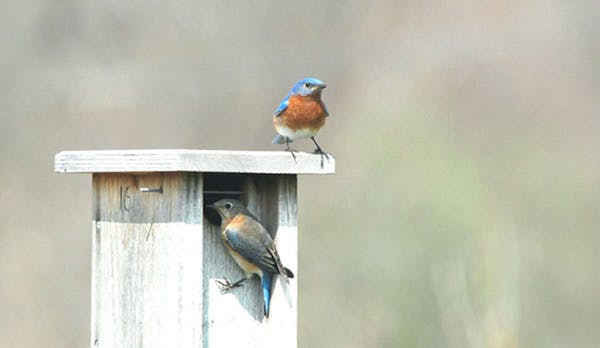On a fine Monday morning in May, a bluebird lays her first egg. She produces another one the next day, another on Wednesday and her fourth and last blue egg is added to her nest on Thursday. Nearly all songbirds do this, laying one egg a day until egg-laying is complete.
It takes about two weeks of being incubated by the mother's body heat for the bluebird embryos to turn into tiny birds. But instead of hatching over four days, tiny young bluebirds tumble out of their shells within hours of each other. This is the norm in the songbird world.
A similar thing happens with waterbirds: A female mallard lays an egg a day over a number of days, averaging 11 eggs over 11 days. Tiny ducklings chip out of their shells all on the same day, about four weeks after the last egg was laid. This is true for most ducks and geese.
How do birds time it so their offspring are all about the same age when they hatch? And why do they do it?
The advantage of having eggs hatch on the same schedule is that this allows parent songbirds to focus on one thing at a time: first brooding embryos in the shell, then feeding youngsters once they emerge.
Imagine if bluebirds started incubating their first egg right away, and continued as each new egg was added to the nest. These eggs would hatch in the order they were laid, with the first chick appearing up to four days before the last. This would be challenging for the parent birds, who'd need to bring in different types and amounts of food for their differently aged nestlings.
And the young bluebirds would be fledging (leaving the nest for good) on different days, a nightmare for parents, who'd still need to keep them safe and fed, some still in the nest, some spread around in nearby trees.
It would be even more challenging for ducks, who tend to have more eggs. A female mallard needs to incubate her eggs for about four weeks. Imagine what would happen if hatching took place over many days: Early ducklings would be scrambling out of the nest while their mother was still sitting on her last few eggs, unable to protect her older offspring.
She needs them to hatch on the same day, because once they dry off, ducklings must all march with their mother toward the water.
The secret to this kind of synchronization is fairly simple — birds wait to begin incubation until all eggs are laid, so their young hatch out within hours of each other. Eggs can withstand being chilled better than they can stand heat, so they're not harmed by waiting for incubation to start or by mothers taking some rest and recuperation.
There's a lot going on behind the scenes at nests all over our area, and by July, young birds will outnumber adults for a brief time.
St. Paul resident Val Cunningham, who volunteers with the St. Paul Audubon Society and writes about nature for local, regional and national newspapers and magazines, can be reached at valwrites@comcast.net
Bigger eggs, longer lag time
Birds that lay larger eggs — swans, herons, cranes and owls — usually have a day or two interval between each egg. Eagles may have three- to five-day intervals between eggs.

The 5 best things our food writers ate this week

A Minnesota field guide to snow shovels: Which one's best?

Summer Camp Guide: Find your best ones here

Lowertown St. Paul losing another restaurant as Dark Horse announces closing






